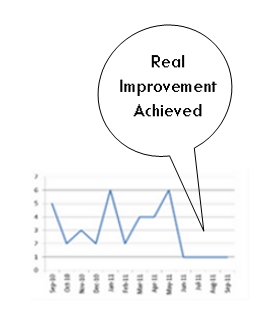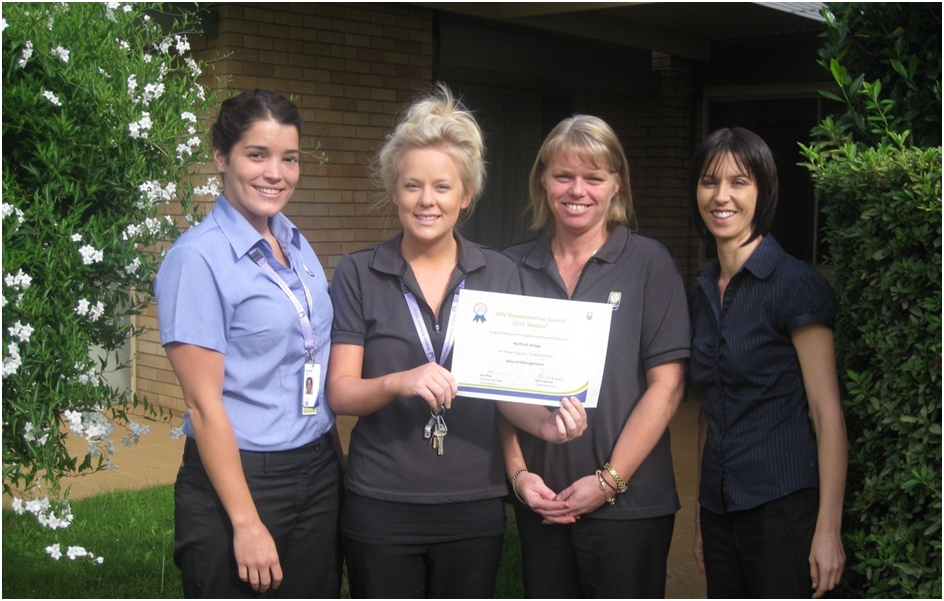ARV Demonstrating Quality 2011 Awards
ARV Demonstrating Quality 2011 Awards
Background
ARV's Clinical Quality Framework was developed in 2010 to underpin innovation in resident care. The Framework has been implemented across the entire organisation through standards, policy and education. Training in Clinical Quality includes education in the 9 step PDSA Improvement Cycle. ARV is involved in benchmarking with QPS Benchmarking and uses the results of clinical indicator monitoring to track and evaluate performance in Residential Aged Care facilities. The following Quality Improvement initiative demonstrates one example of the results achieved in improving clinical care for their residents.
Identify An Opportunity For Improvement
Through direct clinical observation and communication between registered nurses and other staff it became increasingly evident that the registered nurses were spending considerable time attending wound dressings. A question arose as to whether staff were achieving the best outcomes for residents with their current wound management processes. From the review of wound information a hypothesis was formed that the wound care processes and the dressing products used for wound management may be adversely affecting wound healing times and infection rates.
Select the Team
Once the opportunity for improvement was identified and the hypothesis formed, a multi-disciplinary quality improvement team was established. Working out who should be involved was important as particular expertise was required to "solve the problem".
The team comprised of staff from within the facility responsible for the delivery of clinical care to residents. An external member was recruited to the team based on their particular expertise in wound management and training. Each member was given specific roles and functions so their contribution to the project would draw on their individual area of expertise.
Study the Current Situation
Additional data on wound management was required to gain a better understanding of what was occurring at the time. Data was collected on date of injury, the type of dressing used, the frequency of dressing change and healing time. Once this information was collated and analysed we were able to establish specific areas for improvement. These were:
- Wound healing times for skin tears;
- Wound infection rates
An additional outcome would be the introduction of standardized wound care protocols to better assess the effectiveness of the strategy selected.
Analyse the Causes
Before the team could develop solutions or implement any changes to practices which would lead to improvements, the "root" causes of the problems needed to be identified.
The data collected showed that different wound care practices and products were being used and confirmed there was no "standardized" system in place.
A literature search was undertaken to identify if the current antiseptic used in wound cleaning was beneficial or detrimental to wound healing and the prevention of infection. Findings revealed that current antiseptic lotion being used was not the most effective.
All registered nurses involved in the provision of wound care were assessed to determine the effectiveness of their clinical practice which found variation in techniques used.
Develop and Implement a Theory for Improvement
Once the above causes were identified and discussed, it was easy for the team to know what action needed to be taken to make improvements. A comprehensive list of action items were developed and allocated to specific team members who had expertise in their various fields. For example, the clinical leader and external wound care consultant were responsible for designing the new wound care protocol and providing education and training to the registered nurses.
Action items included the following:
- Development of a new wound care protocol;
- Implementation of a new protocol as the single method for managing skin tears;
- Provide staff with education and training;
- Provide encouragement to staff to change their practices and follow the new wound protocol;
- Veto orders from staff requesting "other" wound care products;
- Initiate search and destroy patrols to remove illicit wound care products which staff had brought into the facility themselves;
- Provide constant monitoring of the use of the new wound care protocol;
- Continuously gathered data re: wound healing times;
- Compare wound healing times against older data;
 Study the Results
Study the Results
The initial data showed that from March - August 2010 wounds were taking an average of 26.3 days to heal
As a result of the changes introduced "the average days for wounds to heal" was reduced significantly to 15.2, equating to a reduction of 42%. This remarkable improvement was measured and tested more than once to support the assertion that the results were valid.
Wound Infection rates pre and post changes and training were also measured and the above graph shows the significant decrease in infections.
Infection rates, which peaked in January and May of 2011 had reduced to a single infection after implementation of the project. This level remained low in the subsequent months.
Standardise the Improvement
The clinical leader had ownership of the new clinical protocols and to ensure the improvements are standardised and sustained, clinical practices were regularly observed and monitored.
 The team and all staff involved in resident care were rewarded for their achievements when they received the ARV Quality Award in October 2011.
The team and all staff involved in resident care were rewarded for their achievements when they received the ARV Quality Award in October 2011.
In photo L-R: Rachel Bourke (RN), Lauren Kidd (RN), Narelle Phillips (Facility Manager), Dee Arciuli (Nurse Educator).
0 comments